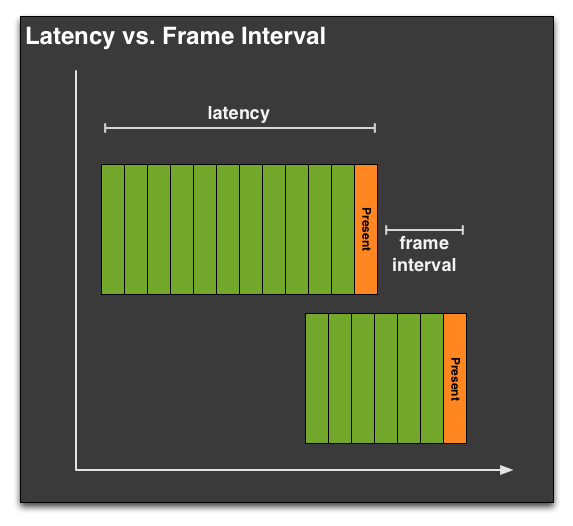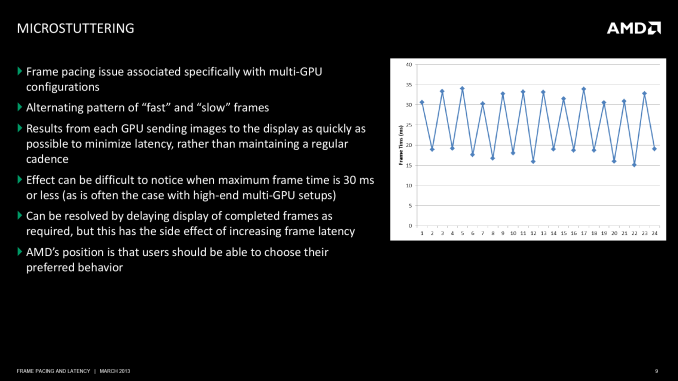AMD Frame Pacing Explored: Catalyst 13.8 Brings Consistency to Crossfire
by Ryan Smith on August 1, 2013 2:00 PM ESTIn Summary: The Frame Pacing Problem
Before we dive into the technical details of AMD’s frame pacing mechanism and our results, we’re going to spend a moment recapping the basis of the frame pacing problem. So if you haven’t been keeping up with this issue, please read on, otherwise feel free to jump a page.
In brief, in multi-GPU setups, be it single-card products like the GTX 690 or multiple cards such as a pair of 7970s, the primary mode of splitting up work is a process called Alternate Frame Rendering (AFR). In AFR, rather than have multiple GPUs working on a single frame, each GPU gets its own frame. This method has over time proven to be the most reliable method, as attempting to split up a single frame over multiple GPUs (with their relatively awful interconnect) has proven to be unreliable and difficult to get working. AFR in contrast is by no means perfect and has to deal with inter-frame dependency issues – where the next frame relies in part on the previous frame – but this is still easier to implement and more consistent than previous efforts at splitting frames.

However due to the mechanisms of AFR, left unattended it can significantly impact the intervals between frames and consequently whether stuttering is perceived. To do AFR well it’s necessary to pace the output of each GPU such that each GPU is delivering a rendered frame at as even a rate as possible; not too soon after the previous frame, and not too late such that the following frame comes up quickly. In a 2 GPU setup, which is going to be the most common, this means the second GPU needs to produce a finished frame when the first GPU is roughly half-way done with its current frame. Should this fail to happen then we have poorly paced frames that will result in perceived micro-stuttering.
Micro-stuttering has been a longstanding issue on multi-GPU setups. Both NVIDIA and AMD have worked on the issue to various degrees, but at the end of the day multi-GPU setups have never proven to be as reliable as single-GPU setups, which is why our editorial position on the matter has been to always favor single powerful GPUs over multiple GPUs when at all possible. Consequently it’s impractical to fully solve micro-stuttering and achieve frame pacing consistency on level with single-GPU setups, but it’s still possible to improve on previous methods and achieve a level of frame pacing that is reasonably effective and “good enough” for most needs. This is what AMD has been focusing on for the past few months.
Moving on, how AMD ended up in this situation is effectively the combination of three factors. The first of course being the innate technical challenged posed by AFR, while the second and third factors have been a poorly realized position on lag vs. consistency and a failure of competitive analysis respectively.
On the former, AMD’s position up until now has been that they’ve favored minimizing input lag in their designs. If you need to hold back a frame to better pace it, then you are by definition introducing some input lag, a quality that is generally undesirable to a user base that usually avoids mechanisms like v-sync for that reason. AMD’s position hasn’t been wrong of course, but it has come at the exclusion of allowing a bit of input lag to better manage frame pacing. AMD’s decision then has been to lighten up on this position and dedicate the resources to deal with both approaches. AMD would introduce advanced frame pacing as an optional control, while leaving the simpler, less laggy approach as another option.
Meanwhile the story with competitive analysis is far less complex. Simply put, AMD wasn’t testing for frame pacing as part of their standard competitive analysis, so when these results first broke AMD was caught flat-footed. This is a business failure rather than a technical failure, which makes it easy enough to resolve. But it’s also the reason why AMD needed time to develop an advanced frame pacing mechanism, as they had never seen the need to develop one before.
Ultimately this is a problem that should have never happened, and it is unfortunate that AMD let it come to this. At the same time however we believe it’s never too late for redemption, and AMD has been making all of the right moves to try to achieve that. They have been clear about their failures and shortcomings, including their frustrations that they’ve left performance on the table by not looking for these issues, and they have been equally clear in laying out a plan for how they would go about fixing all of this. So today we will finally get to see first-hand whether AMD’s initial efforts for resolving frame pacing in multi-GPU setups has paid off.











102 Comments
View All Comments
chizow - Friday, August 2, 2013 - link
Agree for the most part, but I wouldn't go as far to say boycott AMD, I'd say it's a good learning experience for AMD fans. In order to better their own products, they need to be forthcoming and honest about their experiences. If something's broken, demand a fix, don't sit there and dismiss or minimize the problem, or worst, deflect the issue toward the competition in denial. In the end, they just end up hurting themselves by gimping the products they enjoy.Will Robinson - Tuesday, August 13, 2013 - link
Please go back to spamming the comments section at Tech Report with your NVDA shill buddy Wreckage.Its beyond boring having to read it here too.
chizow - Friday, August 2, 2013 - link
Tom Petersen, Technical Marketing Director for Nvidia, has stated Nvidia has had built-in frame metering provisions since at least G80. Nvidia invented modern day AFR and they have clearly put a lot of thought behind it with the science to back it up. Every time you see them talk about AFR/microstutter/runtframes you see a lot of detailed technical slides and backup. Not so much from AMD. It should be obvious why Nvidia has had less of an issue with microstutter, they actually knew what they were looking to fix.http://techreport.com/review/22890/nvidia-geforce-...
"Nvidia's Tom Petersen threw us for a loop by asserting that Nvidia's GPUs have had, since "at least" the G80, a built-in provision called frame metering that attempts to counteract the problem."
Sabresiberian - Thursday, August 1, 2013 - link
Tech Reports is a competing company to AMD?While it is very good to see AMD making progress here, it is far from over for both AMD and Nvidia. Both companies have work to do to get frame rates to be consistent and high.
BryanDobbins - Saturday, August 17, 2013 - link
my neighbor's mom makes $72/hour on the internet. She has been unemployed for 7 months but last month her pay check was $19114 just working on the internet for a few hours. Read more on this web site... http://goo.gl/qHdAQ4Mondozai - Thursday, August 1, 2013 - link
Always liked Ryan's articles but I hope he gets to write more for this site in the future. For example, he should write more about mobile GPU's now that that area is gaining importance(this year we get to see PowerVR's newest generation, Rogue and next year we get to see Kepler in Tegra 5). Yet he didn't write anything on Tegra 5's Kepler story on this site even if he is the expert on GPU's.Doing a story on AMD drivers is all well and good but honestly, would like to see moar.
Ryan Smith - Thursday, August 1, 2013 - link
We have some in-depth mobile coverage scheduled for later this year, though I can't go into any more detail on it at this moment.mwildtech - Thursday, August 1, 2013 - link
Great write up! Thanks Ryan!SeeManRun - Thursday, August 1, 2013 - link
It wasn't totally clear from reading, but is there any point in upgrading to this driver if you have a single graphics card? It doesn't appear so.DanNeely - Thursday, August 1, 2013 - link
Release notes aren't out yet; but the 3rd page mentions that it adds full OpenGL ES 3.0 support as well as other not yes specified improvements. Most likely they include the obligatory few games to get a performance boost; but it's not purely a crossfire update.